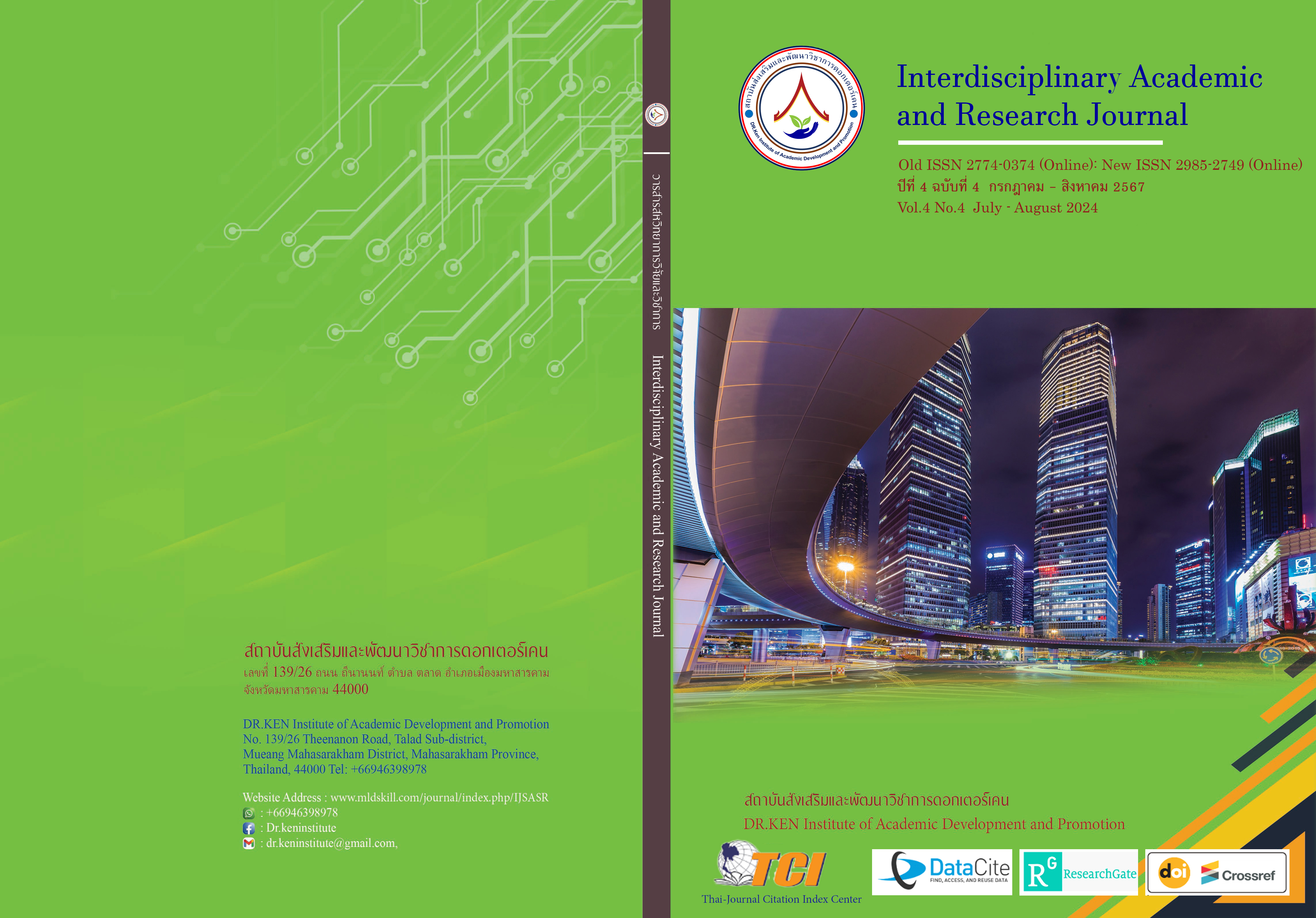The Model of Collaboration Network through Participation Action Research to Develop the Working Process of Cultural Tourism Network in Lampang Province
DOI:
https://doi.org/10.60027/iarj.2024.276988Keywords:
Model; , Participation Action Research; , Collaboration Network; , Cultural TourismAbstract
Background and Aims: The study had three objectives: 1) to develop the Lampang cultural tourist attractions database, 2) to create and determine the efficiency of the model of collaboration network through participation action research, and 3) to compare the process of cultural tourist attractions network before and after using that model.
Methodology: The sample consisted of 60 people interested in this project and played a role in extending development based on cultural capital, such as subdistrict headmen, village headmen, communities, teachers, and representatives from the subdistrict administration organization. The instruments included the model of the collaboration network, knowledge test, and the process of cultural tourist attractions network assessment form. The research is divided into 3 phases: Phase 1: Development of a database of cultural tourist attractions in Lampang Province; Phase 2: Creation and efficiency of the cooperation network model; Phase 3: Comparing the work processes of the cultural tourism network partners in Lampang Province before and after using the cooperation network model. The data was analyzed using percentage, average, and standard deviation.
Results: The study's results were as follows: 1) In the cultural tourist attractions database, there was the network structure, objectives, regulations, activity, guidelines for encouraging the network to perform their roles concretely, and the promoting video clips. 2)There were 4 components in the model of collaboration network through participation action research which were 2.1) Background: introduction, concept, and principle, 2.2)The model process: objective, content, learning management process, trainees’role, speakers’role, contributing factor, measurement and evaluation, 2.3) Result, and 2.4) Applying. The model is appropriate at a high level and the effectiveness in the small group is 84.02/83.81 which met the criteria. 3) The work process of the cultural tourist network after using the model was higher than before using it.
Conclusion: 1) In the cultural tourist attractions database, the network structure, objectives, regulations, activity, guidelines for encouraging the network to perform their roles concretely, and the promoting video clips. 2)There were 4 components in the model of collaboration network through participation action research 3) The work process of the cultural tourist network after using the model was higher than before using it.
References
กระทรวงการท่องเที่ยวและกีฬา. (2561). การท่องเที่ยวอย่างยั่งยืน. กรุงเทพฯ: พี ดับบลิง พริ้นติ้ง.
กุลทัต หงส์ชยางกูร และ ปรัชญานันท์ เที่ยงจรรยา. (2560). การสร้างและการบริหารเครือข่าย. Retrieved on 12 October 2022, from: http://hsmi2.psu.ac.th/upload/forum/paper_1598_5f69ce9304e915f69ce.pdf
ฉวีวรรณ เคยพุดซา. (2561). การพัฒนารูปแบบการจัดการเรียนรูปแบบ RAJASEE เพื่อส่งเสริมความสามารถในการคิดแก้ปัญหาของนักเรียนชั้นมัธยมศึกษาปีที่ 4 โรงเรียนราชสีมาวิทยาลัย. วารสารจันทรเกษมสาร, 24(47), 64-78.
เดชา ลุนาวงค์ (2565). ความต้องการจำเป็นในการพัฒนาภาวะผู้นำครูด้านการจัดการเรียนรู้ตามหลักปรัชญาของเศรษฐกิจพอเพียง โรงเรียนบ้านโคกก่องมิตรภาพที่ 86 สังกัดสำนักงานเขตพื้นที่การศึกษาประถมศึกษาบึงกาฬ. Interdisciplinary Academic and Research Journal, 2(6), 776–780.
ทิศนา แขมมณี. (2560). ศาสตร์การสอน. กรุงเทพฯ: สำนักพิมพ์แห่งจุฬาลงกรณ์มหาวิทยาลัย.
บุญชม ศรีสะอาด. (2560). ความรู้เบื้องต้นเกี่ยวกับงานวิจัย. กรุงเทพฯ: สุวีริยาสาส์น.
ประสาท เนืองเฉลิม. (2563). วิจัยการเรียนการสอน. กรุงเทพ: สำนักพิมพ์จุฬาลงการมหาวิทยาลัย.
พิมพิกา นวนจา และ ศิริพงษ์ ลดาวัลย์ ณ อยุธยา (2563). ภาคีเครือข่ายการจัดการท่องเที่ยวของหมู่บ้านแม่กำปอง ตำบลห้วยแก้ว อำเภอแม่ออน จังหวัดเชียงใหม่. วารสารรัฐศาสตร์และรัฐประศาสนศาสตร์, 11(2), 29-54.
ศศิพิสุทธิ์ หงส์สมบัติ และ ศศิพิมพ์มาศ หงส์สมบัติ. (2563). การวิจัยเชิงปฏิบัติการแบบมีส่วนร่วมเพื่อฟื้นฟูตลาดชุมชน ตำบลบัวทอง อำเภอเมืองบุรีรัมย์ จังหวัดบุรีรัมย์. วารสารวิชาการมหาวิทยาลัยราชภัฏเพชรบุรี, 10(2), 50-60.
ศิริพร ถาวรวิสิทธิ์ และ เสรี วงษ์มณฑา. (2564). แนวทางการส่งเสริมการท่องเที่ยวเชิงวัฒนธรรมของจังหวัดน่าน.วารสารสมาคมนักวิจัย, 26(1), 244-256.
สมเกียรติ พันธรรม และ ชิตพล ชัยมะดัน. (2563). รูปแบบการบริหารจัดการชุมชนท่องเที่ยวเชิงวัฒนธรรมในเขตพัฒนาพิเศษภาคตะวันออก กรณีศึกษา ชุมชนปากน้ำประแส จังหวัดระยอง. วารสารวิชาการบัณฑิตวิทยาลัยสวนดุสิต, 16(3), 89-106.
สมนึก ภัททิยธนี. (2556). การวัดผลการศึกษา. กาฬสินธุ์: ประสานการพิมพ์.
สัญญา ยือราน และ ศิวิไลซ์ วนรัตน์วิจิตร (2561). การวิจัยเชิงปฏิบัติการแบบมีส่วนร่วม สู่ความสำเร็จการเปลี่ยนแปลงนโยบายในระบบสุขภาพ. วารสารเครือข่ายวิทยาลัยพยาบาลและการสาธารณสุขภาคใต้, (5)2, 288-300.
สำนักงานสภาพัฒนาการเศรษฐกิจและสังคมแห่งชาติ.(2560). แผนพัฒนาเศรษฐกิจและสังคมแห่งชาติฉบับที่สิสอง พ.ศ. 2560-2564. Retrieved October 2, 2022, from: https://www.nesdc.go.th/ewt_dl_link.php?nid=6422.
สำนักงานสภาพัฒนาเศรฐกิจและสังคมแห่งชาติ. (2562). แผนแม่บทภายใต้ยุทธศาสตร์ชาติ 5 ประเด็นการท่องเที่ยวพ.ศ. 2561-2580. Retrieved October 2, 2022, from: http://nscr.nesdb.go.th/wp-content/.
สุมิตร สุวรรณ และคณะ. (2560). การสร้างเครือข่ายความร่วมมือพหุภาคี เพื่อการพัฒนาคุณภาพการศึกษาของโรงเรียนขนาดเล็ก จังหวัดนครปฐม. วารสารครุศาสตร์, 45(1), 282-298.
Crane, P., & O’Regan, M. (2010). On PAR Using Participatory Action Research to Improve Early Intervention. Department of Families, Housing, Community Services and Indigenous Affairs, Australian Government.
International Association for Public Participation (IAP2). (2007). The Spectrum of Public Participation. Retrieved from: http://www.iap2.org/associations/4748/files/IAP2%20Spectrum_vertical.pdf.
Joyce, B.R., & Weil, M. (1996). Models of teaching. London: Allyn & Bacon.
Richey, R.C., & Klein, J. (2007). Design and Development Research: Methods, Strategies, and Issues. Mahwah, NJ: Lawrence Erlbaum Associates, Publishers.
Downloads
Published
How to Cite
Issue
Section
License
Copyright (c) 2024 Interdisciplinary Academic and Research Journal

This work is licensed under a Creative Commons Attribution-NonCommercial-NoDerivatives 4.0 International License.
Copyright on any article in the Interdisciplinary Academic and Research Journal is retained by the author(s) under the under the Creative Commons Attribution-NonCommercial-NoDerivatives 4.0 International License. Permission to use text, content, images, etc. of publication. Any user to read, download, copy, distribute, print, search, or link to the full texts of articles, crawl them for indexing, pass them as data to software, or use them for any other lawful purpose. But do not use it for commercial use or with the intent to benefit any business.
















.png)


